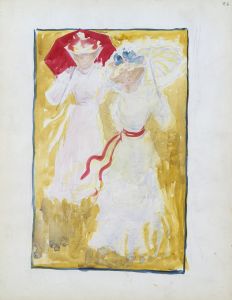
Stack of Wheat
A hand-painted replica of Claude Monet’s masterpiece Stack of Wheat, meticulously crafted by professional artists to capture the true essence of the original. Each piece is created with museum-quality canvas and rare mineral pigments, carefully painted by experienced artists with delicate brushstrokes and rich, layered colors to perfectly recreate the texture of the original artwork. Unlike machine-printed reproductions, this hand-painted version brings the painting to life, infused with the artist’s emotions and skill in every stroke. Whether for personal collection or home decoration, it instantly elevates the artistic atmosphere of any space.
"Stack of Wheat" is one of the series of paintings by the French Impressionist artist Claude Monet. This series, often referred to as the "Haystacks" series, was painted between 1890 and 1891. Monet's "Haystacks" series is renowned for its exploration of light and color, capturing the same subject under varying conditions of light, weather, and seasons.
Claude Monet (1840-1926) was a leading figure in the Impressionist movement, which sought to capture the transient effects of light and color in the natural world. The "Haystacks" series is a quintessential example of this approach. Monet painted these works near his home in Giverny, a village in the Normandy region of France. The haystacks depicted in these paintings were a common sight in the rural French landscape, used for storing wheat and other grains.
The "Haystacks" series consists of around 25 paintings, each portraying the same stack of wheat at different times of the day and year. Monet was particularly interested in how the changing light and atmospheric conditions affected the appearance of the haystacks. He would often work on multiple canvases simultaneously, switching between them as the light and weather changed. This method allowed him to capture the fleeting effects of light with great precision.
One of the key aspects of the "Haystacks" series is Monet's use of color. He employed a wide range of hues to depict the subtle variations in light and shadow. The paintings are characterized by their vibrant, almost shimmering quality, which Monet achieved through his innovative use of broken brushstrokes and a bright, varied palette. This technique helped to convey the impression of light and movement, which is a hallmark of the Impressionist style.
The "Haystacks" series was first exhibited in 1891 and received widespread acclaim. It was praised for its innovative approach to capturing the effects of light and atmosphere. The series also marked a significant development in Monet's career, as it demonstrated his growing interest in series painting—a method he would continue to explore in later works, such as his "Water Lilies" series.
Monet's "Haystacks" series has had a lasting impact on the art world. It influenced many subsequent artists and is considered a landmark in the history of modern art. The paintings are now held in various museums and private collections around the world, including the Musée d'Orsay in Paris, the Art Institute of Chicago, and the Metropolitan Museum of Art in New York.
In summary, "Stack of Wheat" by Claude Monet is part of a groundbreaking series that exemplifies the artist's mastery of light and color. Through his innovative techniques and dedication to capturing the ephemeral qualities of the natural world, Monet created a series of works that continue to be celebrated for their beauty and artistic significance.


















